Future airports could become hi-tech pleasure domes
- Published
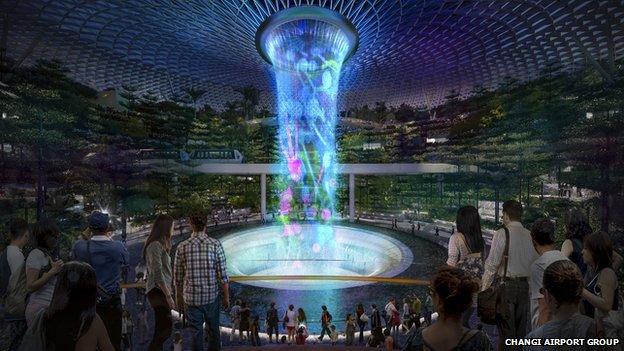
Believe it or not, this is what the Jewel extension to Singapore's Changi Airport will look like
Flight delays, lost luggage, gate change confusion - airports can be stressful to say the least.
But what if technology could make the whole business of air travel more efficient and even pleasurable?
With this in mind, airport operators invested almost $7bn (£4.6bn) on IT services last year, experimenting with automated check-in, navigational apps and new ways of promoting retail opportunities, to name but a few innovations.
And in future we can expect laser-powered security scanners, virtual shopping walls, biometric gates and holographic helpers enhancing our journey experiences and driving up profits for operators.
Welcome to Aeroville!
Airports may even become destinations in their own right - tech-heavy terminals that charm and amaze us.
Take the Jewel expansion at Singapore's Changi Airport, for example.

Airports could become destinations in their own right
When it opens in 2018 its majestic steel and glass design will incorporate five storeys above ground and five below, a huge indoor park with native flora and walking trails, and the world's tallest indoor waterfall - the 40m "Rain Vortex" with its own night-time sound and light displays.
And the recently renovated Tom Bradley International Terminal at Los Angeles Airport gives us another glimpse of the future.
It features the largest immersive multimedia system of any airport in the Americas. Seven huge screens show Southern California scenes and quirky videos, the centrepiece being a 22.5m "time tower" whose striking images constantly change.
These installations also react to passenger movement and real-time flight data.
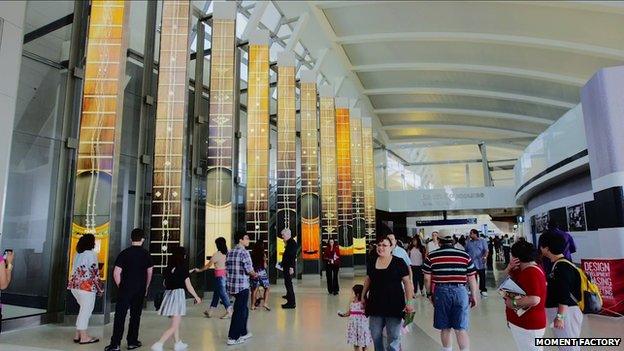
Digital displays react to passers-by at Los Angeles Airport's Tom Bradley International Terminal
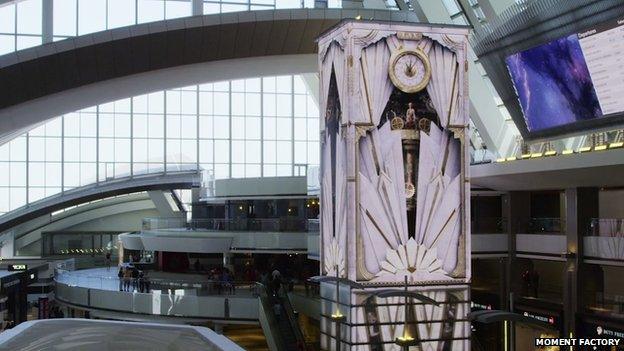
A 22.5m "time tower" is the centrepiece of the terminal's multimedia display
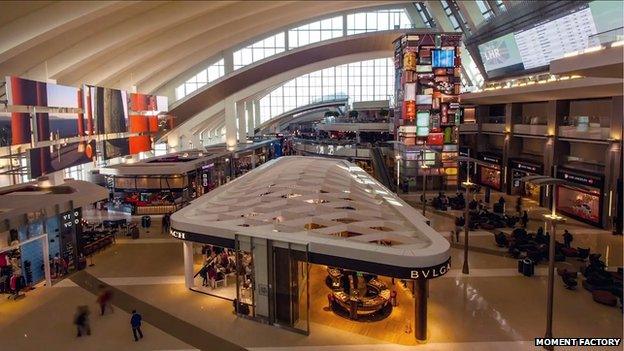
The video displays constantly change to keep travellers entertained
"When we think of technology enhancing experiences, we often think of how it can speed things up, or make things more profitable or convenient," says Peter Firth of the Future Laboratory.
"But the best example of improving an airport that we have seen is less about efficiency and more about poetry."
Don't wait, automate
Tedious airport processes like check-in will increasingly be automated.
London Heathrow and Amsterdam's Schiphol are already trialling self-service biometric passport gates that use facial recognition technology, for instance. And Japan's All Nippon Airways provides travellers with "smart tablets" enabling them to check in quickly, navigate the airport, and receive real-time messages about their flights.
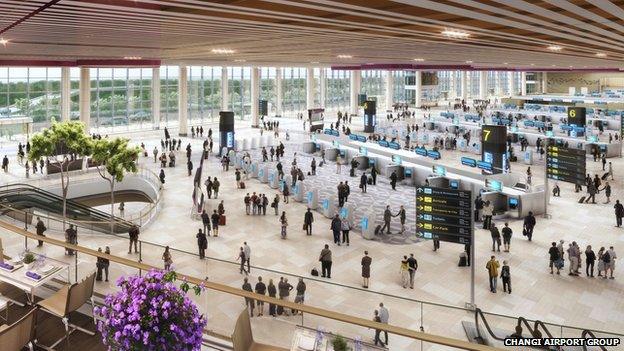
Self-service bag drop and check-in should reduce stressful airport queuing
London's Gatwick Airport, meanwhile, is building the world's largest automated bag drop zone that will allow you to check in luggage as early as 12 hours before a flight, simply by dropping it onto a conveyor belt.
Greg Fordham, managing director of consultancy Airbiz, believes technology will empower travellers.
"In five years' time… an entirely automated airport journey will see the passenger take complete control," he said in a recent report by travel search engine, Skyscanner, external.
Multilingual, multi-skilled airport staff would only be on hand to help passengers in need of assistance, he believes.
Facial recognition
The trend is filtering through to security, too. Gatwick, for instance, uses facial recognition technology to make sure queue time in security is always below five minutes.
"We track your face at four points on the journey through security, to get real-time feedback on how long it is taking," explains Michael Ibbitson, the airport's chief information officer.

Facial recognition technology will speed up passport security checks
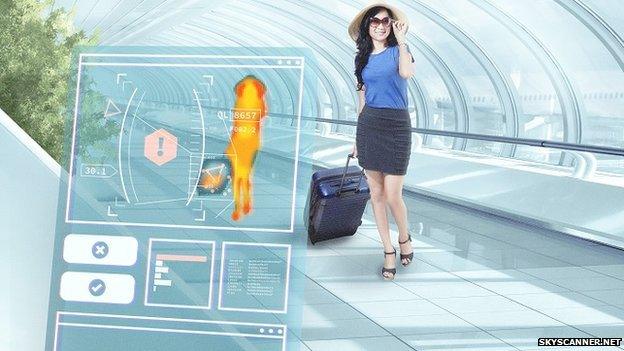
Laser molecular scanners could detect traces of drugs or explosives in organic materials
"Then we combine that data with expected traffic patterns and can proactively open and close security lanes by sending emails to the smartphones of our employees."
Facial recognition technology could extend to discerning expressions or body movements that suggest somebody may be carrying contraband or likely to be a security risk, experts believe, although such technology could fall foul of privacy campaigners.
The laborious X-ray process could be in for a makeover, too.
US firm Genia Photonics has created a "laser molecular scanner" that penetrates clothing and other organic materials to expose traces of explosives or drugs.
The tech, which some speculate will eventually be rolled out at airports, scans multiple people at once and works from a distance of 50m (164ft).
'Transtailing' therapy
It would be nice to think all this technological innovation is for our benefit alone, but in truth it is closely linked to airport profits.
"Faster check-in also means more time to spend at the airport, which creates retail opportunities," says Emre Serpen of IT company Wipro.
"And at some airports non-aeronautical revenues are higher than aeronautical ones."
.jpg)
Virtual shopping walls will make it easier for travellers to organise home deliveries
Perhaps not surprisingly, operators are trialling a host of new technologies designed to make us spend.
Copenhagen, Shanghai Hongqiao and Miami are experimenting with beacon transmitters that send Bluetooth signals to smartphones alerting passengers to discounts or special offers.
And looking ahead we could see the spread of "virtual shopping walls", where shoppers scan QR codes on their smartphones to buy luxury goods or groceries.
These are already present at Gatwick, New Delhi and Frankfurt, but in the future shopping walls could reach a whole new level, believes Skyscanner, with interactive software allowing passengers "to order food or goods with a wave of [their] hand or by a simple verbal command".
Policing the skies
Making airports more efficient and pleasurable is one thing, coping with the expected increase in air traffic is another.
Passenger numbers are expected to reach 7.3 billion by 2034, more than double the 3.3 billion in 2014, the International Air Transport Association predicts, external.
This is likely to mean our skies become more congested, leading to more flight delays and more damaging carbon dioxide emissions.
But the advent of next-generation air traffic management systems could help relieve the pressure.
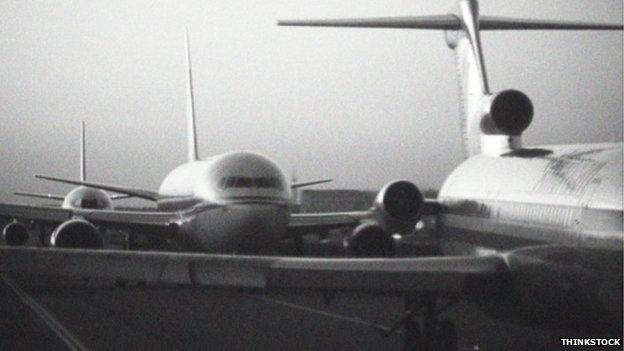
With air passenger numbers expected to double over the next 20 years, how will air traffic control cope?
For example, iTEC, a system developed by Spanish firm Indra, can predict where an aeroplane will be at any point on its journey based on a series of inputs such as radar, flight plan and weather.
This means the air traffic controller can create a "conflict free" plan for each aircraft which requires fewer changes of altitude and thrust, making flights smoother, faster and less polluting.
Indra says iTEC shaves 30-40 nautical miles off a flight from Frankfurt to North America crossing Scottish airspace, potentially equating to £122m in fuel savings annually.
The system will eventually cover German, Spanish, Dutch and UK airspace.
In the US, the Federal Aviation Administration (FAA) is rolling out its own system, Next Gen, between 2012 and 2025, in an attempt to reduce the annual $31bn cost of delays.
GPS technology will enable planes to fly closer together, take more direct routes and avoid delays caused by airport "stacking" as planes wait for an open runway.
But the programme has been subject to delays, and in July 2013 the inspector general of the US Department of Transportation claimed that implementing Next Gen could cost significantly more than the initial $40bn estimate and take as much as 10 years longer than planned - a claim the FAA denied.


Tomorrow's Transport is a series exploring innovation in all forms of mobility against a backdrop of global warming and rising population.
